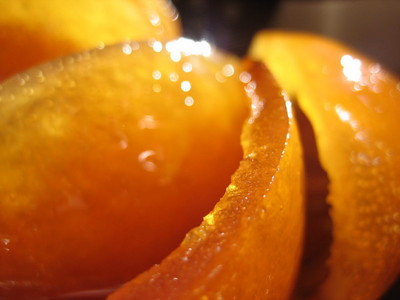Christmas special part 1 – Carlo’s candied citrus peel
Well, a lot has happened in 3 weeks. We enjoyed a traditional American Thanksgiving chez Alex and Nicole, which, despite Alex nearly knocking Nicole out with a plate of oysters, the dog yaffling a whole triple-creme cheese off the board during the commotion, and later getting to the turkey before we did, was a most enjoyable feast. I finished my internship at Chez Panisse, which was a little traumatic – involving much sobbing followed by several medicinal Manhattans. I learnt so much there, loved cooking in a professional kitchen every day, met some wonderful people and properly fell in love with the place. And, somewhere in between these incidents, I candied a new batch of citrus peels, sourced some suet and had several restaurant mates around for a mammoth Christmas cake and pudding making session, at which a round of eggnog was the only American concession.
 I realise Stir-up Sunday has passed, but it’s not too late to make Christmas cake and pudding (should you be so inclined, and probably British). Although, I recommend keeping the pudding til Xmas ’08, as
I realise Stir-up Sunday has passed, but it’s not too late to make Christmas cake and pudding (should you be so inclined, and probably British). Although, I recommend keeping the pudding til Xmas ’08, as
the one-year-old pud we ate at the pudding party was even more delicious
than its sibling which we ate in April.
So, here is your first Christmassy recipe – candied citrus peel. The cake, pudding and eggnog will follow shortly.
All candying methods are pretty similar. This one comes from Carlo Middione, an Italian restaurateur in San Francisco. You could condense the process by doing step one first thing on day one, then steps two and three that evening. But I think it’s more relaxing to spread it out. Use your delicious candied peel for Christmas cakes and puddings, mince pies and chocolate-dipped treats. Save the candying syrup for cocktails, ice creams and caramel sauces…
Recipe: Carlo’s candied citrus peel.pdf
Makes: as much as you want
Total time: a week
several oranges, lemons, limes, grapefruits etc, as you desire
water
salt
sugar
- Day one: Cut the fruits in half across their equators, squeeze the juice out and drink it. Make a solution of 1 litre (4+ cups) water to 1 tablespoon salt. If you have lots of fruit, you may need 2 or 3 times this amount – it must be enough to cover the peels in a non-reactive container. Weigh the peels down in the solution with a plate and leave overnight somewhere cool.
- Day two: Drain the peels. Using a small metal spoon, scoop out the insides of the peels. You should be able to get underneath the membrane and scrape it all out in one go. Rinse the peels in cold water. Place them in a stainless steel saucepan and cover by at least 2″ cold water. Cover and bring to a boil. Remove lid and boil 2 mins. Drain. Now repeat this two more times, each time using fresh cold water. After final draining, let peels cool to room temperature, then store in fridge overnight in a plastic bag.
- Day three: Make what’s called a ‘simple syrup’ by boiling up a solution of equal parts (weight or volume) sugar and water. How much you need depends on how much peel you are candying – there needs to be enough syrup to cover the peels in a saucepan. Boil the syrup for 10 mins, then lower in the peels, making sure they are all submerged. Lower the temperature so that the liquid is just simmering, extremely slowly. Cook peels like this for at least 4 hours, and preferably 5. Stir gently occasionally. Then turn off the heat and let peels cool in syrup overnight. Your house will smell divine.
- Day four: Set a rack over a rimmed baking tray. Lift the peels out of the syrup, one by one, and line them up on the rack cut-side down to drip dry. Place the tray somewhere dry and warm for several days. Decant the syrup into a plastic tub and store it in the fridge for other uses.
- Day seven(ish): By now the peels should be very tacky. How long this takes depends on the humidity of your house – it could be one day or five. Sprinkle each piece of peel all over with plenty of sugar. Store them in an airtight plastic tub or glass jar in the fridge. They will keep for at least a year. You should occasionally check they are not going soggy. If so, air-dry them on a rack again, and sprinkle with more sugar, to avoid mould.

 Follow
Follow
Comments are closed